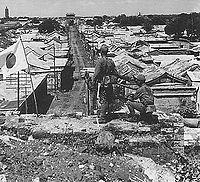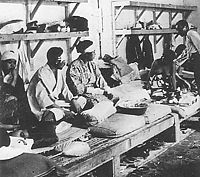
Tungchow Mutiny
Encyclopedia


East Hopei Army
The East Hopei Army was raised from the former soldiers of the Peace Preservation Corps that had been created by the Tangku Truce of 31 May 1933...
in Tōngzhōu
Tongzhou District
Tongzhou District is a district of Beijing, the capital of People's Republic of China. It is located in southeast Beijing and considered the eastern gateway to the Chinese capital...
, China
China
Chinese civilization may refer to:* China for more general discussion of the country.* Chinese culture* Greater China, the transnational community of ethnic Chinese.* History of China* Sinosphere, the area historically affected by Chinese culture...
on 29 July 1937 shortly after the Marco Polo Bridge Incident
Marco Polo Bridge Incident
The Marco Polo Bridge Incident was a battle between the Republic of China's National Revolutionary Army and the Imperial Japanese Army, often used as the marker for the start of the Second Sino-Japanese War .The eleven-arch granite bridge, Lugouqiao, is an architecturally significant structure,...
that marked the official beginning of the Second Sino-Japanese War
Second Sino-Japanese War
The Second Sino-Japanese War was a military conflict fought primarily between the Republic of China and the Empire of Japan. From 1937 to 1941, China fought Japan with some economic help from Germany , the Soviet Union and the United States...
.
In early 1937, Tōngzhōu
Tongzhou District
Tongzhou District is a district of Beijing, the capital of People's Republic of China. It is located in southeast Beijing and considered the eastern gateway to the Chinese capital...
was capital of the East Hopei Government
East Hebei Autonomous Council
The East Hebei Autonomous Council also known as the East Ji Autonomous Council and the East Hopei Autonomous Anti-Communist Council, was a short-lived Japanese puppet state in northern China in the late 1930s.-History:...
, a Japanese puppet state
Puppet state
A puppet state is a nominal sovereign of a state who is de facto controlled by a foreign power. The term refers to a government controlled by the government of another country like a puppeteer controls the strings of a marionette...
controlling the strategic eastern district of Beijing
Beijing
Beijing , also known as Peking , is the capital of the People's Republic of China and one of the most populous cities in the world, with a population of 19,612,368 as of 2010. The city is the country's political, cultural, and educational center, and home to the headquarters for most of China's...
. In July, a detachment of approximately 800 troops of the Chinese 29th Army, under the command of General Sung Che-yuan and loyal to the Kuomintang
Kuomintang
The Kuomintang of China , sometimes romanized as Guomindang via the Pinyin transcription system or GMD for short, and translated as the Chinese Nationalist Party is a founding and ruling political party of the Republic of China . Its guiding ideology is the Three Principles of the People, espoused...
government, camped outside the walls of Tōngzhōu. Refusing to leave despite the strong protests of the Japanese garrison commander, the Japanese did not know that General Sung had reached an agreement with East Hopei leader Yin Ju-keng
Yin Ju-keng
Yin Ju-keng; was a politician in the early Republic of China, later noted for his role as in the collaborationist Provisional Government of the Republic of China and Nanjing Nationalist Government during the Second Sino-Japanese War.-Biography:...
, who hoped to use Sung's Kuomintang
Kuomintang
The Kuomintang of China , sometimes romanized as Guomindang via the Pinyin transcription system or GMD for short, and translated as the Chinese Nationalist Party is a founding and ruling political party of the Republic of China . Its guiding ideology is the Three Principles of the People, espoused...
troops to rid himself of his Japanese overlords.
On 27 July, the Japanese commander demanded that the Kuomintang
Kuomintang
The Kuomintang of China , sometimes romanized as Guomindang via the Pinyin transcription system or GMD for short, and translated as the Chinese Nationalist Party is a founding and ruling political party of the Republic of China . Its guiding ideology is the Three Principles of the People, espoused...
soldiers disarm. When they refused, fighting erupted the following day, and the outnumbered and outgunned Chinese troops were trapped between the Japanese and the city wall. However, the Kuomintang Chinese troops' unwillingness to surrender in what was essentially a suicide mission
Suicide mission
The term suicide mission commonly refers to a task which is so dangerous for the people involved that they are not expected to survive. The term is sometimes extended to, but is not limited to, suicide attacks such as kamikaze and suicide bombings, where the people involved actively commit suicide...
strongly affected the Japanese-trained 1st and 2nd Corps of the East Hopei Army
East Hopei Army
The East Hopei Army was raised from the former soldiers of the Peace Preservation Corps that had been created by the Tangku Truce of 31 May 1933...
who were attached to the Japanese army. When East Hopei Army units refused to press the attack, Japanese troops bombed their barracks on the evening of 28 July. On midnight of 28 July, some 5000 troops of the 1st and 2nd Corps of the East Hopei Army mutinied, turning against the Japanese garrison. In addition to Japanese military personnel, some 250 civilian residents of Tōngzhōu were killed in the uprising (predominantly Japanese reserves, including police and ethnic Korean-Japanese). According to Japanese sources, the majority of women were raped and some were brutally killed. Only around 60 Japanese civilians survived, but much of the city was destroyed in the fighting.
The massacre shocked public sentiment in Japan, and was used to justify further military intervention for protecting Japanese property and lives in Beijing.

